Brett Forrest travels to the farthest reaches of Mongolia to eat goat the Genghis Khan way
Upon landing in Ulaanbaatar, I wasn’t surprised to learn that Mongolian barbecue is not Mongolian at all. Genghis Khan didn’t feed his army on stir fry. Research tells me that a Taiwanese man formulated Mongolian barbecue some years ago, and I think I know why he chose the name that he did. When you use Mongolia as an adjective, it intensifies any noun beside which you place it. Warrior: Mongolian warrior. Vodka: Mongolian vodka. Girlfriend: Mongolian girlfriend. Taiwanese barbecue? Hardly worth a taste.
In the way of intensity, Mongolia doesn’t disappoint. The country is double the size of Turkey, yet there are only two highways, making transport a frontiersman’s undertaking. Temperatures bottomed out at minus -42 degrees when I was there, yet many Mongolians are content to live in circular enclosures made of fabric. These people ambulate nomadically around the country along some of the remotest land in the world, their camps set against lonely winter tableaux, not a soul in sight. It raises some questions: how do they survive? What do they eat? If Mongolian barbecue wasn’t Mongolian, then what dish was Mongolian? I made some effort to answer these questions, and what I discovered is not for the weakly constituted. It is Mongolian, and it is intense.
It is called bodog (bow-dug), and I drove eastward from Ulaanbaatar to find it. My excited local companions (fixer, photographer) bragged that we were driving on a paved road. Just as they said so, the asphalt ran out. Passing a village of clustered huts, where a dirt-faced boy was playing with what appeared to be a juvenile wolf, we left all cars behind. The drive was several hours of frozen streams, snowy pathways, and ravines that howled with emptiness. Forest speckled the hillsides, and I could make out stumps where people had felled trees for fuel. It was a scavenger countryside.
We arrived at a small homestead. Smoke issued from the chimneys of two gers, the traditional Mongolian dwelling. This was the home of a man named Narantunglag, and his wife, Bujinlham. They were each 32 years old, but they looked older, life on the range doing their features no favors. Each year, Narantunglag, Bujinlham, and their three-year-old daughter Bayasgalan picked up stakes with the seasons, moving their herd of sheep, goat, and steer around the country in search of grazing grounds. This area, Terelj, was their winter encampment.
A small corral stood near their gers. One section held a half-dozen undersized cows. In the other, a single goat about knee-high, its fleece a muddy orange, stomped on its hooves, searching nervously for an exit from the wooden stockade. It appeared nervous, though that could have been my imagining, for I knew what was coming.
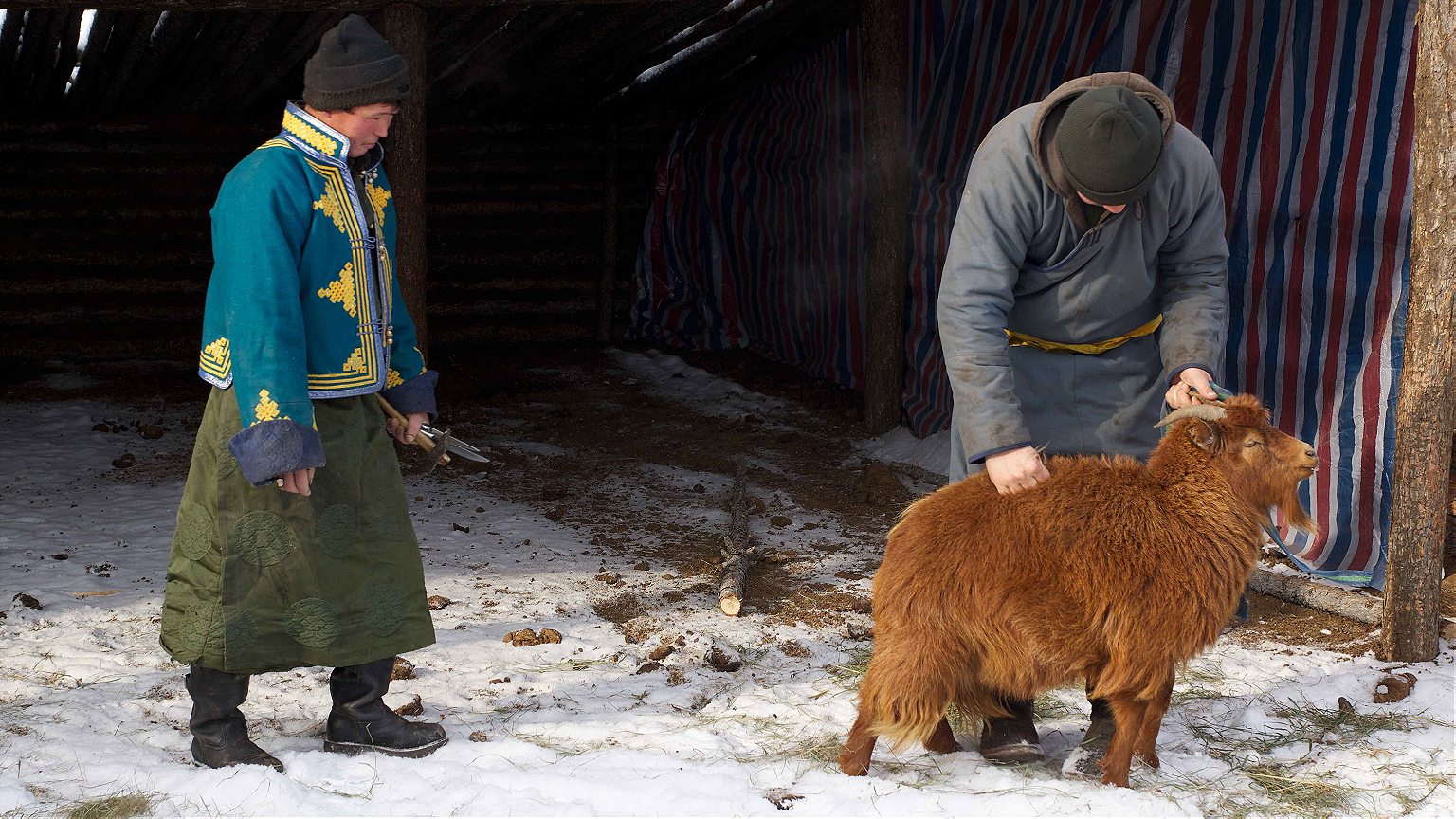
It happened quickly. The small door of one of the gers opened, and Narantunglag stepped outside. He was a bit less than six feet tall, and slim. His dogs, a round-up of mongrel pups, nosed at his knees and nipped playfully at his felt boots. Narantunglag’s brother-in-law, Ganzorig, who was a bit younger and smaller but no less solemn about what was to come, followed him out of the ger. The two marched to the corral dressed in their colorful, calf-length national costume, known as a del.
Upon seeing the men, the goat bolted into a corner, then turned around, finding nowhere to go. Ganzorig grabbed the animal by its horns. Narantunglag raised a metal hammer. He aimed at the weak spot of the goat’s crown. With two short blows, the hammer breached the animal’s skull. The goat collapsed to the floor of the corral.
For a moment, the goat lay still. Then its whole body twitched, as though shocked by electrical current. The animal’s legs kicked through a gallop, hooves scattering the hay that marked the ground. The men stood over the goat and watched as the kicking slowed. It stopped. The men were still, as was the goat, the only movement the lonely winter wind.
Narantunglag and Ganzorig slung a rope over the roof that extended halfway over the corral, hanging the goat’s weight by its horns. The animal’s hooded eyeballs suggested a drowsiness as much as death. Its mouth hung slack. Steam curled out between its spread of small herbivore teeth. Ganzorig removed a small, plastic-handled knife from the sash of his del. He made an incision in the goat’s neck, then worked the blade around until he returned to the place he had begun. Blood trickled down the fur and dripped onto the ground. One of the goat’s hind legs pawed at the air, but Ganzorig didn’t notice. He was busy with an ancient Mongolian ritual, by which an animal’s meat is roasted within its own skin.
In Ulaanbaatar, I had met with the president of the Mongolian Cook’s Association, a middle-aged gentleman who bore the given name of the bygone socialist time, Oktyabri (October) Janchiv. He wore blocky, shaded prescription glasses. During our talk, he routinely produced a comb from his jacket pocket and jazzed his black hair upward. He spoke in marbled, academic Russian. I thought of him as the Mongolian Brezhnev, and he knew everything about bodog. He said that bodog dated to the time of the khans. “When Genghis Khan had a victory,” Janchiv said, “he would make bodog for everybody in large banquets.” Janchiv explained that bodog was elemental to the success of the roving Mongol armies, as the process required no crockery. “Mongols were not good with clay or porcelain. So this was the most effective way of cooking at that time.” Even half of civilization is plenty to conquer, and this is how the Mongols did it, without vulnerable food supply lines, killing what they encountered, using an animal’s earthly vessel as the pot and pan that would otherwise weigh down a combatant horseman.
It didn’t take Ganzorig long to expose the vertebrae of the goat’s neck, and soon he had peeled the animal’s fur to the shoulders. The carcass twisted this way and that, as Ganzorig made careful not to puncture the skin, so as to not compromise the air-tight seal the skin would need to make later. Over the next several hours, I watched Narantunglag and Ganzorig slowly divest the goat’s fleece of everything that was held within it, slicing out meat and bone, collecting these pieces on a platter at their feet. With kicks and threats, they kept Narantunglag’s dogs away from the plate. The dogs instead snatched up the bits of fat and tendon that flecked from the goat to the ground.
The men worked with nonchalance, cigarettes dangling from their lips, unaffected by the cold, though they wore little that I would call winter gear. Bundled up in many layers, I was the one ducking inside the main ger to get warm. There was a central stove inside, its chimney running skyward through the small window at the apex of the ger, the only natural light source. Guests were meant to sit on the left side of the room on a daybed, women on a daybed to the right, the man of the house on a chair straight ahead. As is traditional, the furniture was painted orange, with colorful ornamentation. There was a small dresser, backed by a mirror, with a Mickey Mouse Clock tick-tocking the time. Bujinlham perched on a pillow, watching a tiny black-and-white TV screen. (They owned a generator.) A movie was playing, 3:10 to Yuma. It was the more recent vintage of the film, with two wealthy actors pretending to be desperate men clawing out a life on the edge of the landscape. As her daughter chewed on her sweater cuff, Bujinlham could not be bothered, lost in the world of the movie.
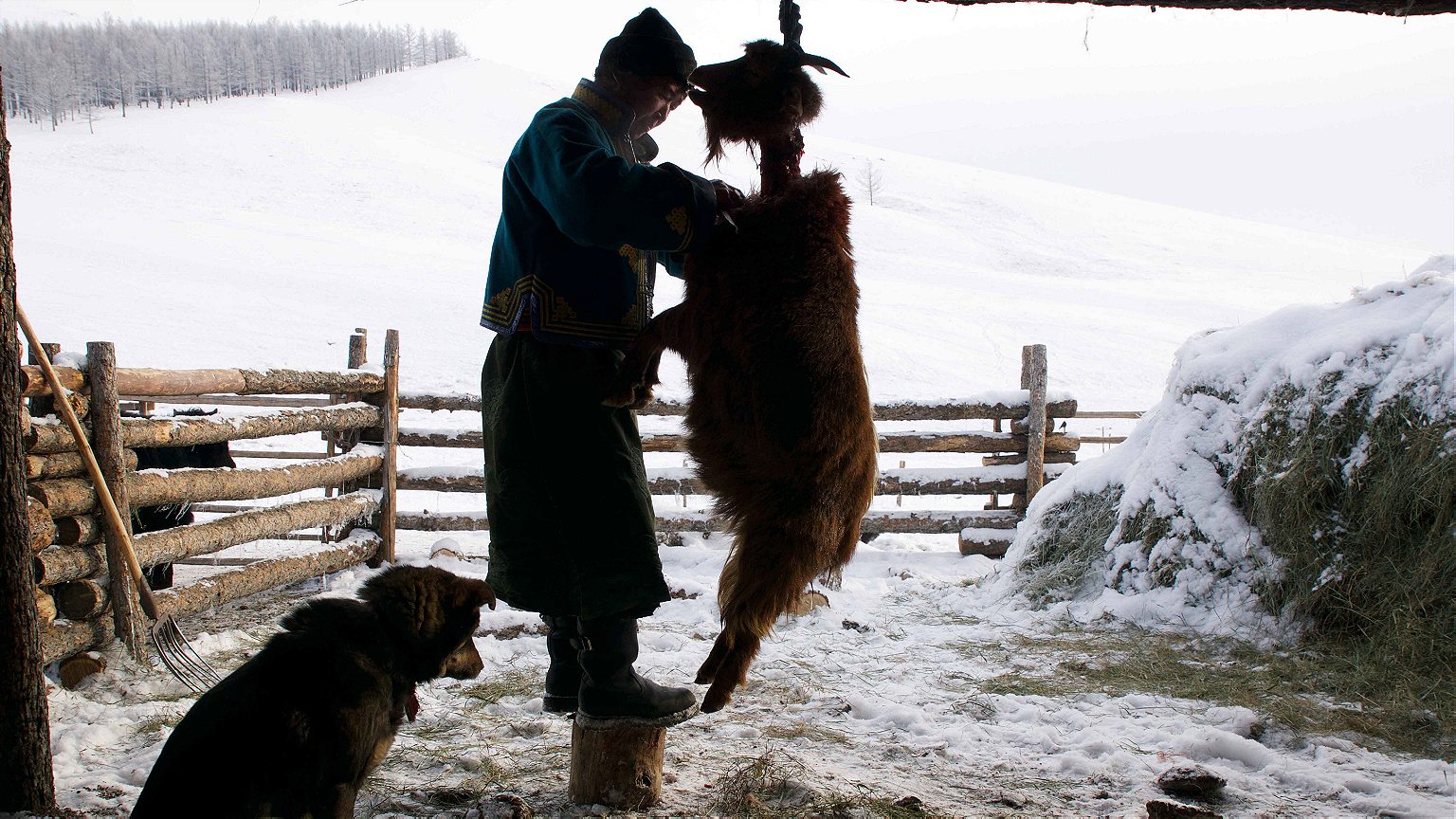
Outside, the goat’s spine snapped a foot beneath its head, and the carcass dropped to the ground. Narantunglag removed the head from where it hung and placed it in a pail. The head’s opened eyes superintended the continued slaughter. The carcass now hanging on a wire run between two spinal vertebrae, Narantunglag worked the knife carefully through bone and tendon. “The ribs and the hips are the hardest,” he said. “You have to be very careful not to rip the skin with your knife. And if you don’t take out the intestines and stomach cleanly, the contents can spill.”
Ganzorig positioned himself on his haunches and supported the goat from underneath, allowing Narantunglag some slack to work the knife around the hips. Blood pooled in a mess of organs. Ganzorig shifted his feet. This caused the blood to slosh around in the goat’s body. The liquid lapped over the skin and splashed Ganzorig’s face. He barely flinched.
Brown pellets issued from the goat’s bowels, spilling like jackpot coins to the ground and mixing with the flecks of tissue on the tamped-down grass and straw. Looking away, I caught sight of Narantunglag’s herd of sheep and goat, which came into view on a nearby hill, dark specks against the snow. The goat that Narantunglag and Ganzorig were dismantling once belonged to that group, and those animals migrated up the incline, pausing now and again to kick at the snow with their hooves and find the grasses underneath it. Over the distance, a sheep’s bleating call reached me, and then the answer of another. When I looked back to the slaughter, I noticed that the pellets were all gone from the ground, along with the tissue, the dogs indiscriminate in their search for protein.
After several hours, with the sun falling over the backside of the hill, the goat was skinned. Narantunglag had broken the carcass’s legs and removed those last bones. The goat’s ruddy, empty fleece hung limply in the crook of his arm. It was time to cook.
Bujinlham brought the platter of meat and bone inside the ger. She added seasoning: salt and pepper, onions, paprika, and the contents of a packet written in Polish. It was called Vigorn, and she sprinkled its dark dust over the meat. She handed the platter to Narantunglag.
A friend of his, Munkhbaatar, had arrived by horse, and along with Ganzorig, they positioned themselves around a fire in front of the ger. Using a pair of metal tongs, Munkhbaatar snatched a stone from the depths of the fire. Narantunglag held open the goat’s fleece, grabbing it around the neck hole. Munkhbaatar placed this hot stone inside it, shoving it into the space of one of the animal’s hind legs.
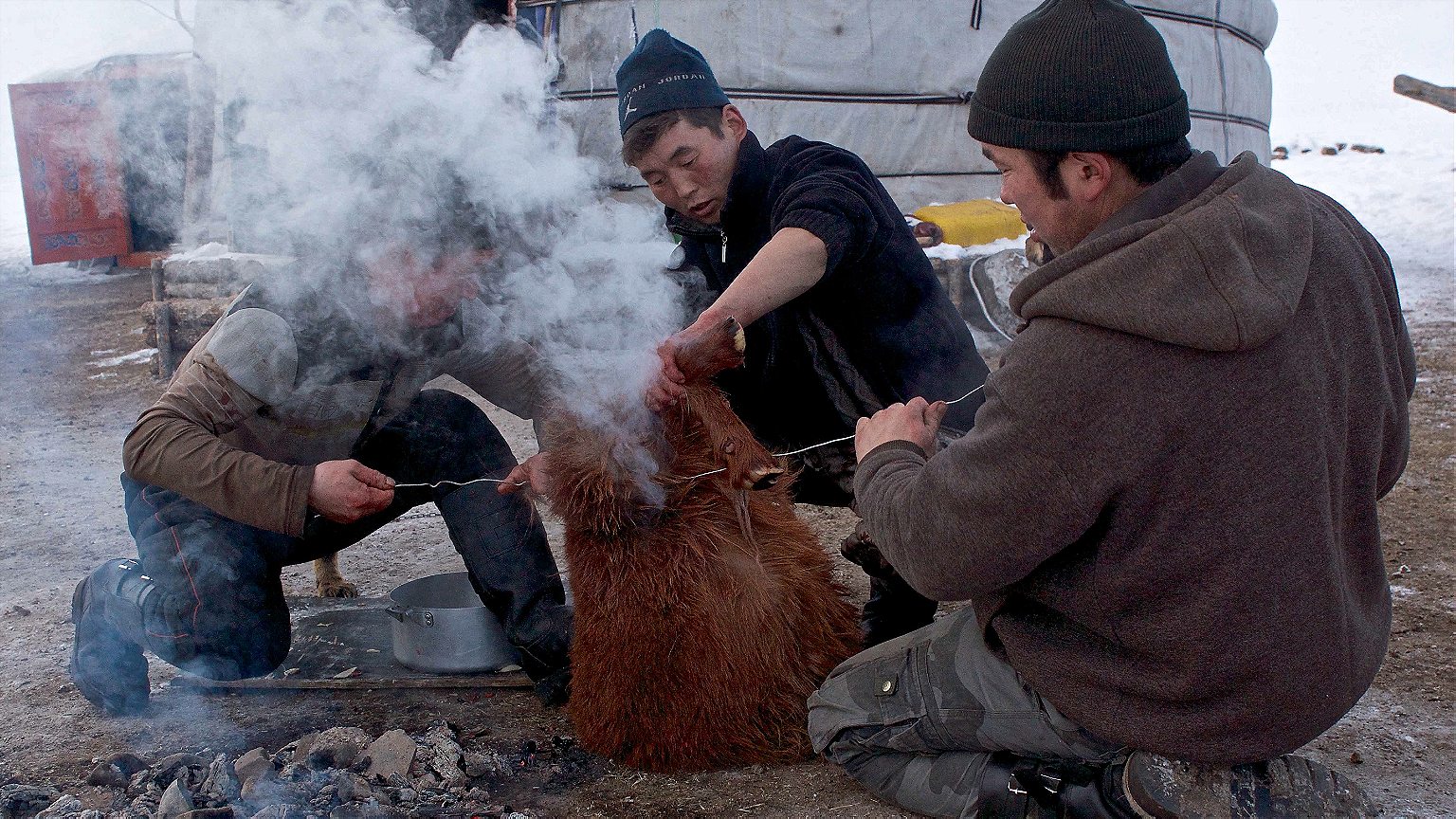
The rock sizzled the flesh. Munkhbaatar filled the empty carcass with a layer of scalding stones, then stepped aside. Ganzorig took several pieces of meat from the platter and placed them inside the fleece. The meat contacted the hot stones, and smoke billowed out of the fleece, making it hard to see.
Narantunglag placed another layer of hot stones into the fleece. Ganzorig inserted another layer of meat. The men worked this way quickly, making sure to hold the developing steam and heat inside the carcass until it was full of meat and stones. They closed the neck opening with a metal wire, cinching it tight.
They brought out the blowtorch. After pulling out the animal’s cashmere coat with their fingers, the men stood aside. Settled on the dirt by the fire, the carcass was now a white, hairless ball, stuffed fat, with four floppy appendages. This was a bodog. Narantunglag lit the torch. He directed the flame at the bodog, running it across the entirety of its exterior, slowly charring it brown. I stood back and watched.
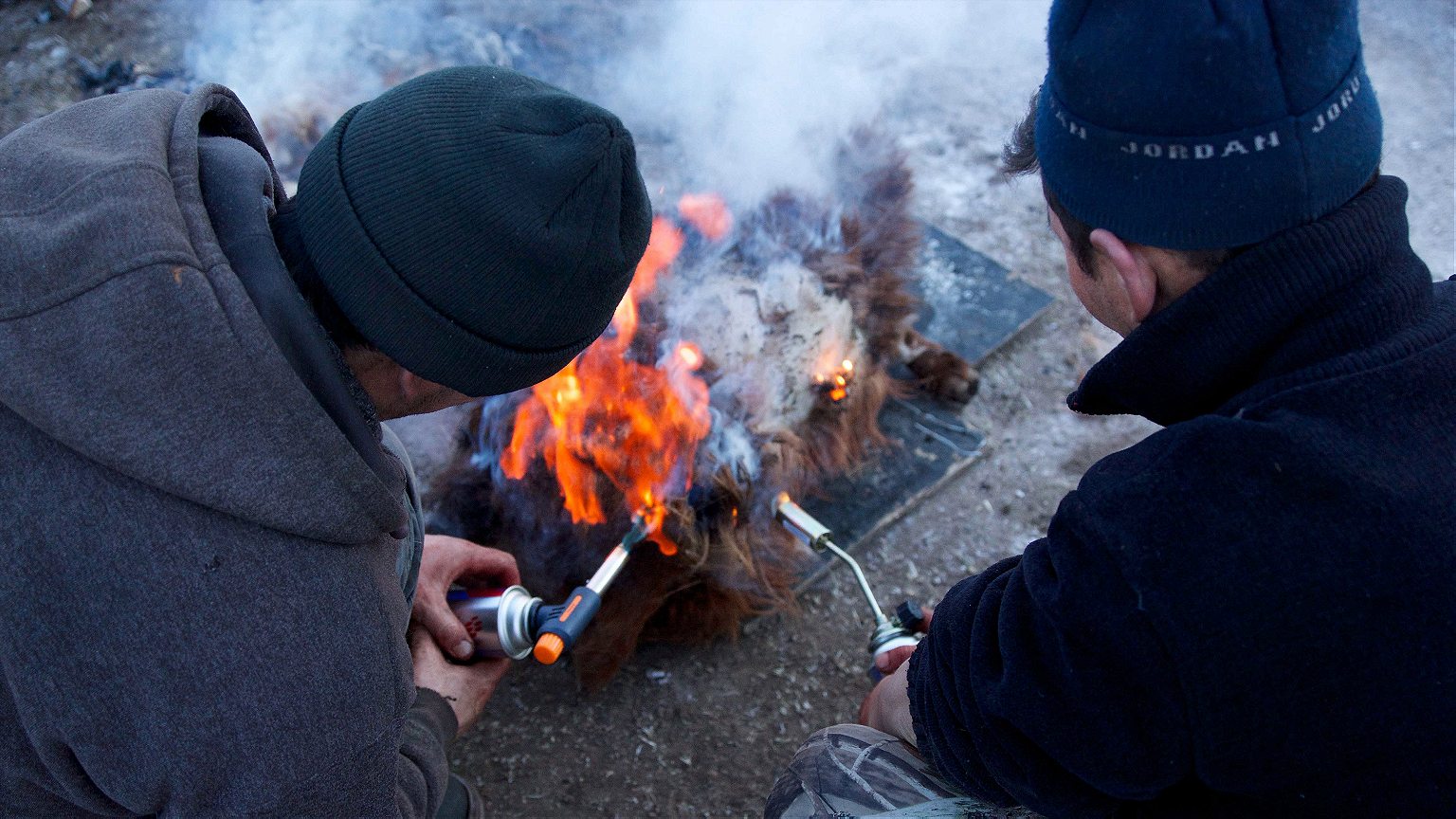
In Ulaanbaatar, Oktyabri Janchiv had explained the process of the bodog. “The stones hold heat evenly,” he had said. “So the meat doesn’t undercook or burn. As the stones roast the meat, the steam acts like a pressure cooker. This creates juice that drips down and collects in the bottom of the sack. This juice starts boiling because of the blowtorch from the outside.”
The cooking took almost two hours. We stood around and waited. Narantunglag pointed to the far hill and said that wolves lived up there. They stole down under darkness and attacked his herd. It was a constant worry. He had a rifle, but the wolves were always there.
The men watched over the bodog, searching for signs that it might be time to eat. They knocked the ball with their fists. They looked for oil seeping out of the neck hole. “It lets you know it’s ready,” Ganzorig said. At last, they said the bodog was finished, and Narantunglag carried it inside the ger.
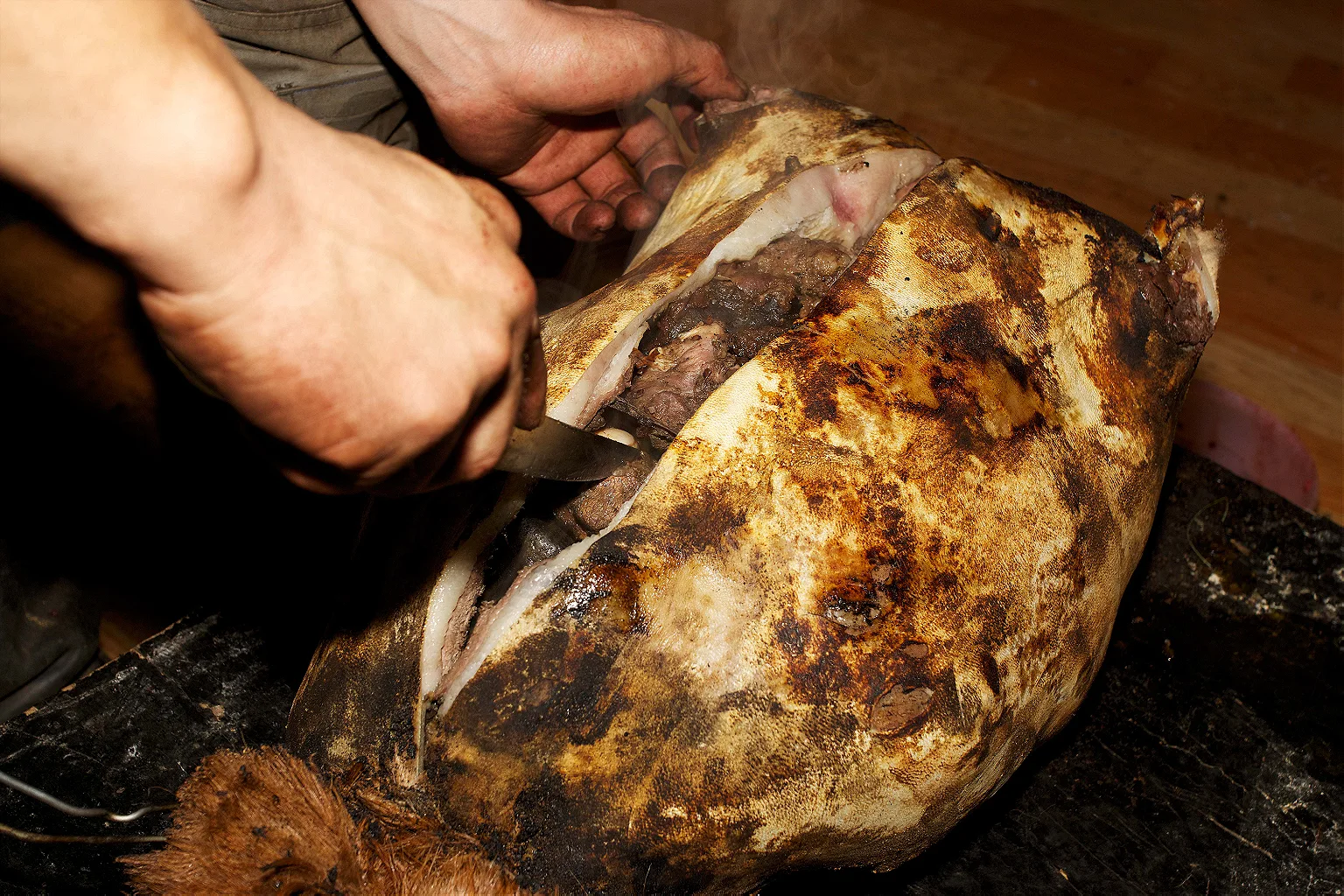
Grabbing the knife they had used to skin the goat, Narantunglag slit open the bodog lengthwise. The skin crackled as the interior steam hissed into the ger. Narantunglag plucked a rock from inside the bodog and handed it to me. The rock was hot, and he told me to pass it back and forth between my hands, as this would frighten off the evil spirits dwelling within me.
The men removed all of the meat from inside the carcass. They placed the food on a plate and set it on a small table. Then they titled the charred remains of the bodog, pouring its liquid contents into a small metal bowl.
Narantunglag handed me this bowl. It was hard to discern it in the weak light of the ger, but I knew what it was. Its glistening revealed this juice to be pure, distilled fat. The men all watched as I lifted it to my lips. I took a healthy gulp. It was hot and thick, and it slimed its way down.
I have sat in fine restaurants, linen napkin across my lap, the slightest pressure needed from my knife as the mutton slid off the bone. This was not that kind of experience. We sat on the floor around a small card table. We ripped into the meat with knives and daggers and our hands. We passed around a plastic cup, taking turns with the vodka.

Frontier meat tends to be dry. This was not the case with the bodog. The meat was tough in spots, tender in others, but it was uniformly bathed in the animal’s natural oils, making it easy to eat. This original sauce gave the mutton a tang. A byproduct of its proximity to the fiery stones, I figured, the meat also tasted slightly smoked. As I savored the meal, my eye strayed from the table and its piling of meat, falling upon a bowl that sat on the floor next to me. In the bowl was the head of the goat we were eating. One eye lay open, appearing to be focused on me.
“Do you eat this all the time?” I asked the table.
“Traditionally, in winter, this is what we eat,” Narantunglag said. “Meat, meat, meat. It’s what we need to survive the climate.” I reached into my mouth and pulled out a long, orange goat hair.
Ganzorig spoke up. “On TV, we hear people say fat is bad for you,” he said. “We’re thinking that maybe we should have less cholesterol, eat more vegetables. But we believe that cuisine is specific to that country.” He lips were greasy, and blood still dotted his cheeks. He lifted a rib from the pile of meat. “In Mongolia, we believe this is what we need to eat to survive these conditions.”
Having overeaten, I wandered outside. The moon was nearly full, and in its light, the dogs lay motionless on the snow, curled up like empty fleeces. The earth was still. And silent. The exhaust from the ger’s stove filtered into the night. I realized that I had found it, the real Mongolian barbecue, and I wore its smoke and fat and gristle all the way back to Ulaanbaatar.
